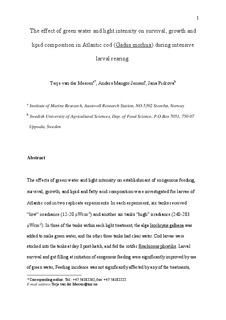The effect of green water and light intensity on survival, growth and lipid composition in Atlantic cod (Gadus morhua) during intensive larval rearing [postprint]
Journal article, Peer reviewed
Permanent lenke
http://hdl.handle.net/11250/108152Utgivelsesdato
2007Metadata
Vis full innførselSamlinger
- Articles [3012]
Sammendrag
The effects of green water and light intensity on establishment of exogenous feeding, survival, growth, and lipid and fatty acid composition were investigated for larvae of Atlantic cod in two replicate experiments. In each experiment, six tanks received “low” irradiance (12-20 μWcm-2) and another six tanks “high” irradiance (240-283
μWcm-2). In three of the tanks within each light treatment, the alga Isochrysis galbana was added to make green water, and the other three tanks had clear water. Cod larvae were
stocked into the tanks at day 3 post-hatch, and fed the rotifer Brachionus plicatilis. Larval survival and gut filling at initiation of exogenous feeding were significantly improved by use of green water, Feeding incidence was not significantly affected by any of the treatments,although low light conditions gave a marginal increase in feeding incidence. Growth was not
affected by any of the treatments, but a tendency to density-dependent growth was observed within green vs. clear water, yielding some improvement in growth with use of algae. However, a significant signal from the algal treatment was detected in the fatty acid composition of the phospholipids and in the relative amount of triacylglycerols in the larval lipids of cod. Thus, the data demonstrate a nutritional vector of algae in larval cod rearing, and the possibly benefit of this on survival. Lack of effects of light intensity contradicts previous studies on larval cod, but point out possible genetic adaptations in this species to variable environmental conditions throughout its distribution area.
Beskrivelse
Journal home page: http://www.elsevier.com/wps/find/journaldescription.cws_home/503302/description#description
